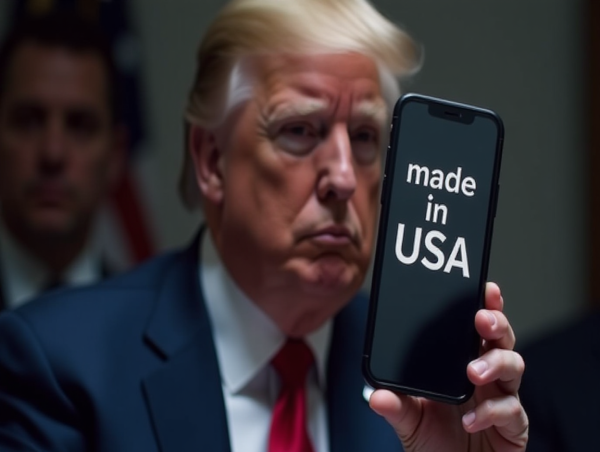Amid US President Donald Trump’s criticism of Apple’s reported decision to shift a substantial portion of its iPhone production for the American market from China to India rather than the United States, experts have cautioned that relocating production to the US would be economically unfeasible—ultimately leaving the company worse off, even though India would lose out on jobs.
Speaking at an event in Qatar on Thursday, Trump revealed he had confronted Apple CEO Tim Cook, calling the decision a disappointment given Apple’s recent commitment to invest $500 billion in the United States.
“I had a little problem with Tim Cook yesterday,” Trump said. “I told him: ‘Tim, you’re my friend. You’re coming here with 500 billion but now you’re building all over India. I don’t want you building in India.’”
Trump said that Apple had long enjoyed favourable treatment in the US despite its substantial manufacturing base in China and added that the time had come for the company to build in the US.
“I said to Tim … we’ve treated you really good, we’ve put up with all the plants that you’ve built in China for years, now you got to build [for] us,” Trump said.
“We’re not interested in you building in India, India can take care of themselves … we want you to build here.”
Trump also said Apple was “going to be upping their production in the United States”, although he did not provide further details to back up the claim.
US assembly would result in a 13-fold increase in labour costs
While Trump’s remarks have underscored a push to onshore more manufacturing, experts have highlighted the economic impracticality of such a move.
Ajay Srivastava, founder of the Global Trade Research Initiative (GTRI), said Apple stands to lose significantly more than India if it shifts assembly to the US due to steep increases in labour and operational costs.
Relocating assembly to the US would result in a 13-fold increase in labour costs—from $290 per month per worker in India to around $2,900 under US minimum wage norms.
This alone would raise the per-unit assembly cost from $30 to $390, slashing Apple’s profit per device from $450 to just $60, unless prices are raised.
Industry estimates suggest that building iPhones in the US could push their retail price to nearly $3,000, a far cry from the current $1,000 price tag.
“A lot better thought would prevail both in the Apple company and the US administration. They would realise the following facts. First, if they decide to manufacture in the USA as compared to China, India, or Vietnam, a USD 1,000 iPhone would cost USD 3,000,” Prashant Girbane, Director General of the Mahratta Chamber of Commerce, Industries and Agriculture (MCCIA), said
Are American consumers willing to pay $3,000 for that iPhone?
India earns less than 3% of the total value but will lose out on jobs
The gains India makes from assembling iPhones are limited in terms of value addition.
While each iPhone made and exported from India brings in approximately $30, much of it is offset through subsidies under India’s Production Linked Incentive (PLI) scheme, and tariff reductions on key smartphone components—often done at Apple’s behest.
“For every iPhone sold at $1,000 in the US, India’s share is less than $30. Yet, in trade data, the full $7 billion export value adds to the US trade deficit,” Srivastava noted.
$30 is less than 3% of the total value, despite being key locations for final assembly.
Still, the final assembly work done in India creates much-needed jobs, with around 60,000 workers currently employed in Apple’s local supply chain.
In China, about 300,000 workers are involved in similar operations. India’s role, while low in value capture, is significant for employment and skills development.
If Apple does shift assembly away from India, Srivastava believes it could serve as a wake-up call for the country to move beyond “shallow assembly lines” and invest in higher-value areas such as semiconductors, batteries, and display technologies.
“The exit could push India to stop depending on final assembly and start building its own upstream ecosystem,” he said.
What to make of Trump’s comments?
Apple’s global supply chain remains heavily China-dependent.
Currently, about 85% of iPhones are made in China, with India accounting for roughly 15%.
Analysts believe Trump’s comments may be aimed at exerting pressure on India in ongoing trade negotiations. Some experts also said Apple is unlikely to scale back its India plans.
NK Goyal, Chairman of the Telecom Equipment Manufacturers Association (TEMA), dismissed Trump’s comments as premature and noted that Apple had exported over $22 billion worth of iPhones from India in the last year.
“Apple already has three factories in India and is planning two more. If it moves out of India, it will suffer losses due to shifting global tariffs and supply chain uncertainties,” Goyal said.
He believes Apple will continue using India as a key manufacturing base.
Supporting this, Jaideep Ghosh, former partner at KPMG, said that iPhones worth Rs 1.75 lakh crore were made in India in FY 2025, up from Rs 1.2 lakh crore the previous year.
“The Apple ecosystem is becoming more important for India,” he said.
Shifting not from the US, but from China
Industry experts also clarified that the manufacturing shift is not from the US to India, but from China to India—a move aligned with the broader geopolitical goal of diversifying supply chains away from Chinese dependence.
Girbane added, “The jobs and manufacturing are not moving away from the US to India; they are moving from China to India. That helps American companies and consumers by protecting them from dependence on a single nation.”
The post Trump wants Apple to shift iPhone production from India to the US: here’s what it means appeared first on Invezz





